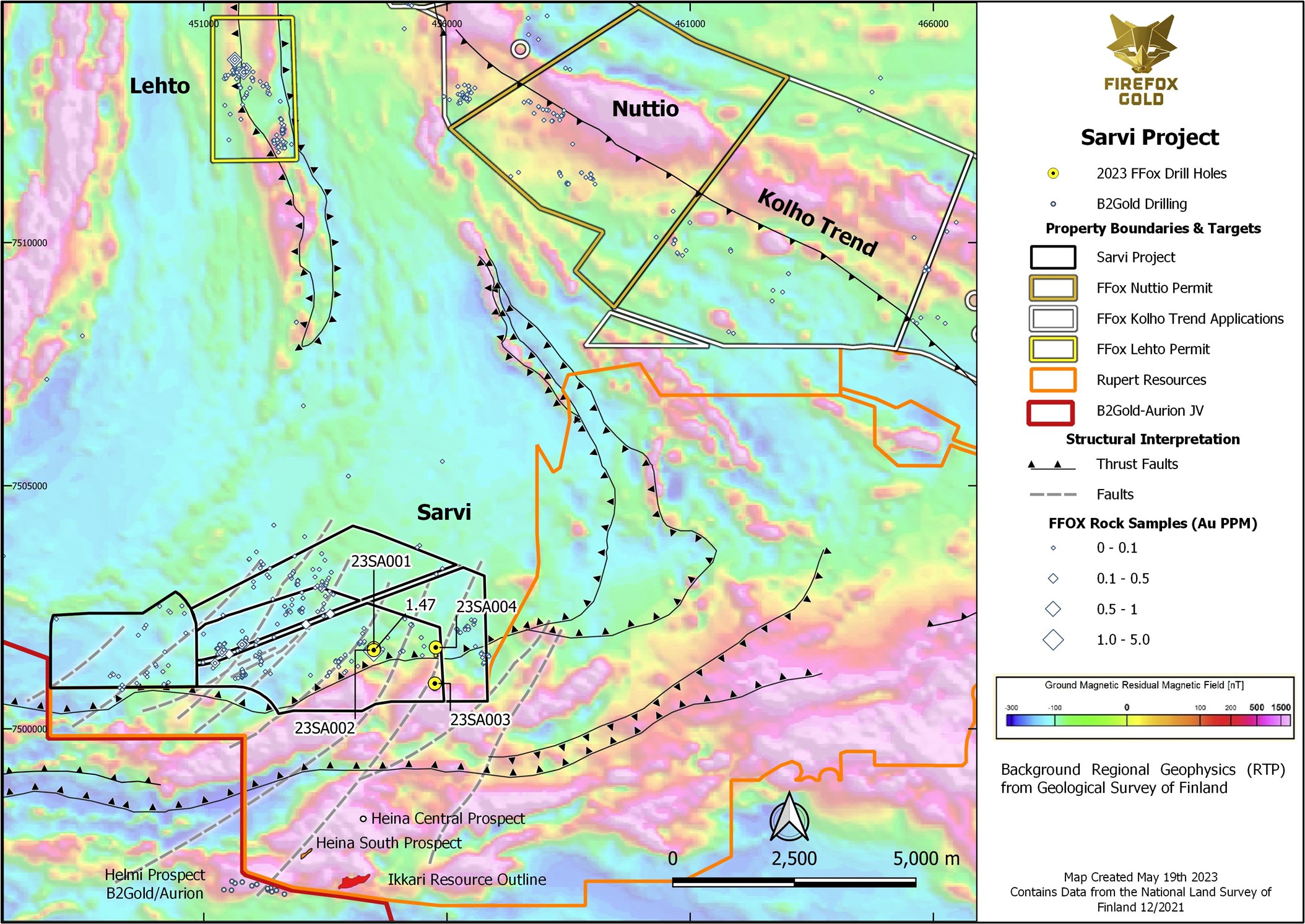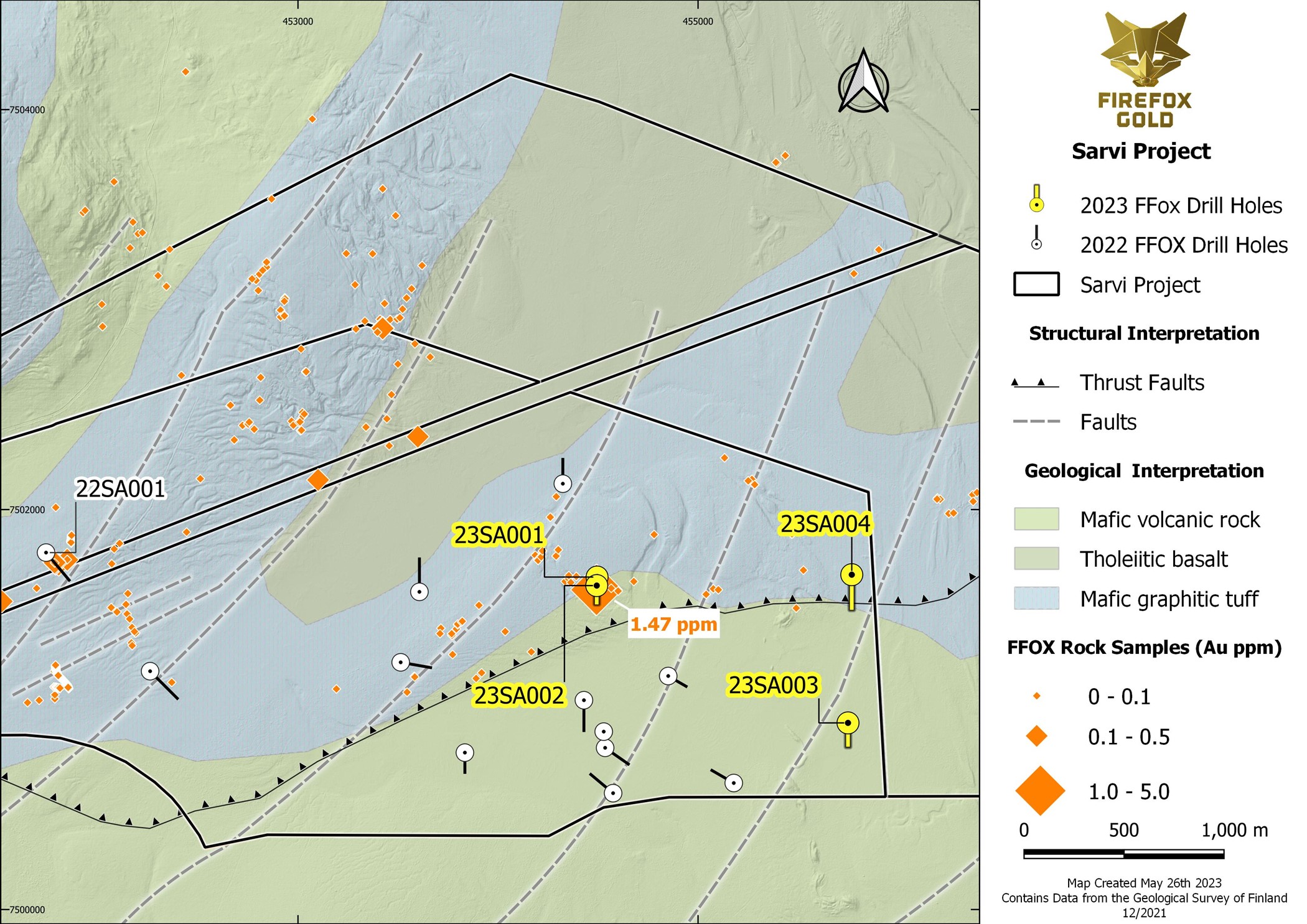
FireFox Gold (TSXV:FFOX) has announced the successful completion of a second diamond drilling operation at its wholly-owned Sarvi Gold Project, situated in Lapland, Finland.
The Sarvi Gold Project lies north of Rupert Resources’ Area 1 Project (Ikkari Deposit). The venture is based on the Sarvi exploration permit and encompasses two further permits, Sarvi-2 to the north and Keulakko to the west, making for a total authorized area of 21 square kilometres. The Sarvi permits cover a section of the Kittilä Suite of volcanic rocks, intersected by several interpreted faults.
FireFox’s CEO, Carl Löfberg, commented in a press release: “We continue to advance our portfolio of assets in Lapland, drilling on two of our five permitted projects during the winter 2023 program. Despite a shortened program at Sarvi due to the onset of spring conditions, the winter drilling was very valuable. The team identified sulphide minerals in three of the four holes and drilled an important sediment-volcanic contact. We can see evidence for multiple stages of deformation at the project along with anomalous gold, silver, and a suite of pathfinder elements that has been shown to be important in Lapland. As is the case for numerous projects in this area, outcrop is sparse, so we plan to expand our base-of-till sampling program to support more drilling. In the meantime, we look forward to receipt of the assays for these four holes.”
The recent exploration drilling program at Sarvi comprised four drill holes, spanning 611 meters. These holes were strategically designed to test a blend of geochemical anomalies from base-of-till (BoT) sampling and structural/geological targets. The project’s geological understanding has been enhanced through a combination of detailed magnetics from drone-based and ground surveys, supplemented with nearly 1,600 BoT samples. This latest drilling round identified quartz-carbonate (tourmaline) veining with sulphides, and sulphide-bearing carbonaceous sediments at a contact with mafic volcanic rocks. Notably, drilling in 2022 also discovered sulphide-rich graphite-bearing tuffs and schists that contained unusually high levels of gold and silver.
Unfortunately, the drilling operation was prematurely concluded due to the swift onset of thawing conditions. Results from the assay for all four drill holes are eagerly anticipated.

Geology and Details
Drill holes 23SA001 and 23SA002, positioned 42 meters apart, were drilled in a south-facing drill fence, targeting a steep magnetic gradient that corresponds with a surface rock sample that resulted in 1.47 g/t Au and 1.86% Cu (see FireFox’s news release dated August 24, 2021). These drill holes intersected mafic volcanic rocks, revealing signs of shearing, folding, and locally intense quartz-carbonate veining, inclusive of chalcopyrite, pyrite, tourmaline, and iron carbonate.
Drill hole 23SA003, drilled approximately 1.4 kilometers southeast of 23SA001 and SA002, explored a magnetic high area disrupted by late faulting, with BoT samples showing arsenic and copper anomalies. The drillhole was directed southwards and passed through a substantial section of mafic volcanic rocks.
Drill hole 23SA004, approximately 750 meters north of 23SA003, was aimed at a strong geochemical anomaly in the BoT sampling, marked by high silver, arsenic, bismuth, tellurium, and molybdenum levels. These elements are often enriched in Lapland gold systems. The hole intersected a sediment-volcanic contact with abundant pyrite in graphite-bearing mudstones and black shales, similar to the anomalous gold and silver intercept from the property’s west side in 2022. Following this interval, the drill hole passed through a gradational contact with mafic volcanic rocks (possibly tholeiitic basalts) around 91m downhole. This contact between the sulphide-bearing mudstones and the basalt provides crucial insights for the ongoing work at Sarvi.
Following this, the drilling fleet was relocated to the Mustajärvi Project area to conduct additional drilling around the high-grade East Target.



 Follow us on Twitter
Follow us on Twitter Become our facebook fan
Become our facebook fan










Comments are closed.